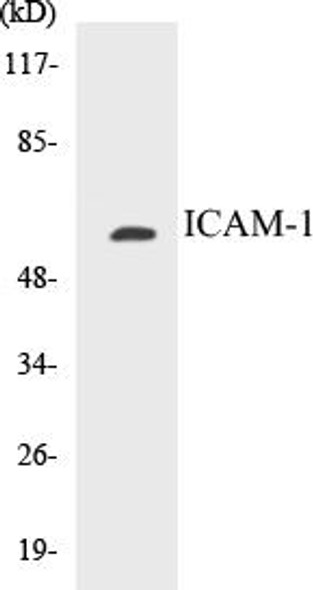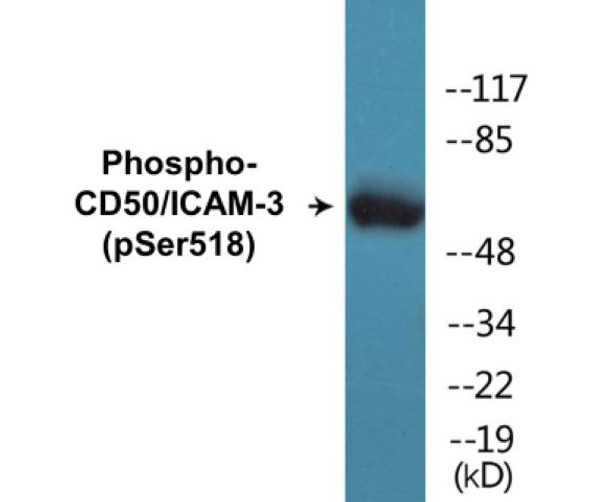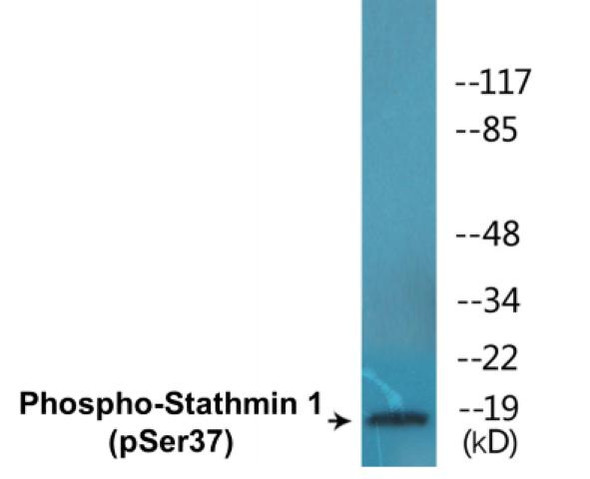Description
ICAM-1 (Phospho-Tyr512)Colorimetric Cell-Based ELISA Kit
The Human ICAM-1 Phospho-Tyr512 Colorimetric Cell-Based ELISA Kit is a cutting-edge tool for detecting and quantifying levels of ICAM-1 phosphorylated at tyrosine 512 in cell lysates. This kit offers unmatched sensitivity and specificity, allowing for accurate and reproducible results in a variety of research applications.ICAM-1, or intercellular adhesion molecule-1, is a cell surface glycoprotein that plays a crucial role in immune response and inflammation. Phosphorylation at tyrosine 512 is known to modulate ICAM-1 function, making it a key target for studying cell signaling pathways and understanding disease mechanisms.
With this advanced ELISA kit, researchers can delve deeper into the role of ICAM-1 phosphorylation in various health conditions, including inflammatory diseases, autoimmune disorders, and cancer. By accurately measuring phosphorylated ICAM-1 levels, valuable insights can be gained for developing novel therapeutic strategies and personalized treatments. Experience the power of precision with the Human ICAM-1 Phospho-Tyr512 Colorimetric Cell-Based ELISA Kit from AssayGenie.
| Product Name: | ICAM-1 (Phospho-Tyr512)Colorimetric Cell-Based ELISA Kit |
| Product Code: | CBCAB01547 |
| ELISA Type: | Cell-Based |
| Target: | ICAM-1 (Phospho-Tyr512) |
| Reactivity: | Human |
| Dynamic Range: | > 5000 Cells |
| Detection Method: | Colorimetric 450 nm |
| Format: | 2 x 96-Well Microplates |
The ICAM-1 (Phospho-Tyr512) Colorimetric Cell-Based ELISA Kit is a convenient, lysate-free, high throughput and sensitive assay kit that can detect ICAM-1 protein phosphorylation and expression profile in cells. The kit can be used for measuring the relative amounts of phosphorylated ICAM-1 in cultured cells as well as screening for the effects that various treatments, inhibitors (ie. siRNA or chemicals), or activators have on ICAM-1 phosphorylation.
Qualitative determination of ICAM-1 (Phospho-Tyr512) concentration is achieved by an indirect ELISA format. In essence, ICAM-1 (Phospho-Tyr512) is captured by ICAM-1 (Phospho-Tyr512)-specific primary (1ø) antibodies while the HRP-conjugated secondary (2ø) antibodies bind the Fc region of the 1ø antibody. Through this binding, the HRP enzyme conjugated to the 2ø antibody can catalyze a colorimetric reaction upon substrate addition. Due to the qualitative nature of the Cell-Based ELISA, multiple normalization methods are needed:
| 1. | A monoclonal antibody specific for human GAPDH is included to serve as an internal positive control in normalizing the target absorbance values. |
| 2. | Following the colorimetric measurement of HRP activity via substrate addition, the Crystal Violet whole-cell staining method may be used to determine cell density. After staining, the results can be analysed by normalizing the absorbance values to cell amounts, by which the plating difference can be adjusted. |
| Database Information: | Gene ID: 3383, UniProt ID: P05362, OMIM: 147840, Unigene: Hs.706750/Hs.707983 |
| Gene Symbol: | ICAM1 |
| Sub Type: | Phospho |
| UniProt Protein Function: | ICAM1: a type I membrane protein of the immunoglobulin superfamily. Is a ligand for the leukocyte adhesion LFA-1 protein (Integrin alpha-L/beta-2) and a Rhinovirus receptor. Typically expressed on endothelial cells and cells of the immune system. ICAM1 binds to integrins of type CD11a / CD18, or CD11b / CD18. Its expression is activated by p53 in an NF-kappaB-independent manner. Induced by TNFalpha in a process that involves IKKbeta. |
| UniProt Protein Details: | Protein type:Immunoglobulin superfamily; Membrane protein, integral; Cell adhesion Chromosomal Location of Human Ortholog: 19p13.3-p13.2 Cellular Component: extracellular space; focal adhesion; cell surface; membrane; integral to plasma membrane; plasma membrane; immunological synapse; external side of plasma membrane Molecular Function:viral receptor activity; integrin binding; protein binding; transmembrane receptor activity; receptor activity Biological Process: entry of virus into host cell; extracellular matrix organization and biogenesis; positive regulation of nitric oxide biosynthetic process; T cell antigen processing and presentation; response to organic cyclic substance; activation of NF-kappaB transcription factor; positive regulation of cellular extravasation; regulation of cell shape; leukocyte adhesion; cellular response to nutrient levels; sensory perception of sound; ovarian follicle development; T cell activation via T cell receptor contact with antigen bound to MHC molecule on antigen presenting cell; membrane to membrane docking; response to sulfur dioxide; cell adhesion; regulation of leukocyte mediated cytotoxicity; acute inflammatory response to antigenic stimulus; response to drug; regulation of cell adhesion; virion attachment, binding of host cell surface receptor; negative regulation of calcium ion transport; regulation of immune response; cytokine and chemokine mediated signaling pathway; response to amphetamine; cell aging; response to amino acid stimulus; heterophilic cell adhesion; positive regulation of peptidyl-tyrosine phosphorylation; response to ethanol; response to copper ion; positive regulation of actin filament polymerization; positive regulation of vasoconstriction; adhesion to host; cell adhesion mediated by integrin; response to ionizing radiation; leukocyte migration Disease: Malaria, Susceptibility To |
| NCBI Summary: | This gene encodes a cell surface glycoprotein which is typically expressed on endothelial cells and cells of the immune system. It binds to integrins of type CD11a / CD18, or CD11b / CD18 and is also exploited by Rhinovirus as a receptor. [provided by RefSeq, Jul 2008] |
| UniProt Code: | P05362 |
| NCBI GenInfo Identifier: | 68067956 |
| NCBI Gene ID: | 3383 |
| NCBI Accession: | P05362.2 |
| UniProt Secondary Accession: | P05362,Q5NKV7, Q96B50, B2R6M3, |
| UniProt Related Accession: | P05362 |
| Molecular Weight: | |
| NCBI Full Name: | Intercellular adhesion molecule 1 |
| NCBI Synonym Full Names: | intercellular adhesion molecule 1 |
| NCBI Official Symbol: | ICAM1 |
| NCBI Official Synonym Symbols: | BB2; CD54; P3.58 |
| NCBI Protein Information: | intercellular adhesion molecule 1; ICAM-1; cell surface glycoprotein P3.58; major group rhinovirus receptor; intercellular adhesion molecule 1 (CD54), human rhinovirus receptor |
| UniProt Protein Name: | Intercellular adhesion molecule 1 |
| UniProt Synonym Protein Names: | Major group rhinovirus receptor; CD_antigen: CD54 |
| Protein Family: | Intercellular adhesion molecule |
| UniProt Gene Name: | ICAM1 |
| UniProt Entry Name: | ICAM1_HUMAN |
| Component | Quantity |
| 96-Well Cell Culture Clear-Bottom Microplate | 2 plates |
| 10X TBS | 24 mL |
| Quenching Buffer | 24 mL |
| Blocking Buffer | 50 mL |
| 15X Wash Buffer | 50 mL |
| Primary Antibody Diluent | 12 mL |
| 100x Anti-Phospho Target Antibody | 60 µL |
| 100x Anti-Target Antibody | 60 µL |
| Anti-GAPDH Antibody | 60 µL |
| HRP-Conjugated Anti-Rabbit IgG Antibody | 12 mL |
| HRP-Conjugated Anti-Mouse IgG Antibody | 12 mL |
| SDS Solution | 12 mL |
| Stop Solution | 24 mL |
| Ready-to-Use Substrate | 12 mL |
| Crystal Violet Solution | 12 mL |
| Adhesive Plate Seals | 2 seals |
The following materials and/or equipment are NOT provided in this kit but are necessary to successfully conduct the experiment:
- Microplate reader able to measure absorbance at 450 nm and/or 595 nm for Crystal Violet Cell Staining (Optional)
- Micropipettes with capability of measuring volumes ranging from 1 µL to 1 ml
- 37% formaldehyde (Sigma Cat# F-8775) or formaldehyde from other sources
- Squirt bottle, manifold dispenser, multichannel pipette reservoir or automated microplate washer
- Graph paper or computer software capable of generating or displaying logarithmic functions
- Absorbent papers or vacuum aspirator
- Test tubes or microfuge tubes capable of storing ≥1 ml
- Poly-L-Lysine (Sigma Cat# P4832 for suspension cells)
- Orbital shaker (optional)
- Deionized or sterile water
*Note: Protocols are specific to each batch/lot. For the correct instructions please follow the protocol included in your kit.
| Step | Procedure |
| 1. | Seed 200 µL of 20,000 adherent cells in culture medium in each well of a 96-well plate. The plates included in the kit are sterile and treated for cell culture. For suspension cells and loosely attached cells, coat the plates with 100 µL of 10 µg/ml Poly-L-Lysine (not included) to each well of a 96-well plate for 30 minutes at 37 °C prior to adding cells. |
| 2. | Incubate the cells for overnight at 37 °C, 5% CO2. |
| 3. | Treat the cells as desired. |
| 4. | Remove the cell culture medium and rinse with 200 µL of 1x TBS, twice. |
| 5. | Fix the cells by incubating with 100 µL of Fixing Solution for 20 minutes at room temperature. The 4% formaldehyde is used for adherent cells and 8% formaldehyde is used for suspension cells and loosely attached cells. |
| 6. | Remove the Fixing Solution and wash the plate 3 times with 200 µL 1x Wash Buffer for five minutes each time with gentle shaking on the orbital shaker. The plate can be stored at 4 °C for a week. |
| 7. | Add 100 µL of Quenching Buffer and incubate for 20 minutes at room temperature. |
| 8. | Wash the plate 3 times with 1x Wash Buffer for 5 minutes each time. |
| 9. | Add 200 µL of Blocking Buffer and incubate for 1 hour at room temperature. |
| 10. | Wash 3 times with 200 µL of 1x Wash Buffer for 5 minutes each time. |
| 11. | Add 50 µL of 1x primary antibodies Anti-ICAM-1 (Phospho-Tyr512) Antibody, Anti-ICAM-1 Antibody and/or Anti-GAPDH Antibody) to the corresponding wells, cover with Parafilm and incubate for 16 hours (overnight) at 4 °C. If the target expression is known to be high, incubate for 2 hours at room temperature. |
| 12. | Wash 3 times with 200 µL of 1x Wash Buffer for 5 minutes each time. |
| 13. | Add 50 µL of 1x secondary antibodies (HRP-Conjugated AntiRabbit IgG Antibody or HRP-Conjugated Anti-Mouse IgG Antibody) to corresponding wells and incubate for 1.5 hours at room temperature. |
| 14. | Wash 3 times with 200 µL of 1x Wash Buffer for 5 minutes each time. |
| 15. | Add 50 µL of Ready-to-Use Substrate to each well and incubate for 30 minutes at room temperature in the dark. |
| 16. | Add 50 µL of Stop Solution to each well and read OD at 450 nm immediately using the microplate reader. |
(Additional Crystal Violet staining may be performed if desired – details of this may be found in the kit technical manual.)






